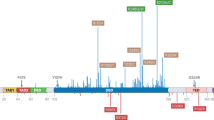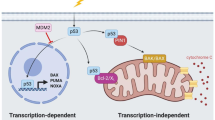Abstract
The anticancer agent paclitaxel (Taxol®) stabilizes tubulin polymerization resulting in arrest in mitosis and apoptotic cell death. Normal human fibroblasts depleted of functional p53 by SV40 T antigen or HPV–16 E6, and primary embryo fibroblasts from p53 null mice showed seven– to ninefold increased cytotoxicity by paclitaxel. Reduced levels of p53 correlated with increased G2/M phase arrest, micronucleation, and p53–independent paclitaxel–induced apoptosis. Surviving cells with intact p53 progressed through mitosis and transiently accumulated in the subsequent G1 phase, coincident with increased p53 and p21cip1,waf1 protein levels. These results are in contrast to studies linking p53 loss with resistance to DNA damaging anticancer agents.
This is a preview of subscription content, access via your institution
Access options
Subscribe to this journal
Receive 12 print issues and online access
$209.00 per year
only $17.42 per issue
Buy this article
- Purchase on Springer Link
- Instant access to full article PDF
Prices may be subject to local taxes which are calculated during checkout
Similar content being viewed by others
References
Gregory, R.E. & DeLisa, A.F. Paclitaxel: A new antineoplastic agent for refractory ovarian cancer. Clin. Pharm. 12, 401–415 (1993).
Horwitz, S.B. Mechanism of action of taxol. Trends. Pharm. Sci. 13, 134–136 (1992).
Schiff, P.B. & Horwitz, S.B. Taxol stabilizes microtubules in mouse fibroblast cells. Proc. Natl. Acad. Sci. USA 77, 1561–1565 (1980).
Donaldson, K.L., Goolsby, G.L. & Wahl, A.F. Cytotoxicity of the anticancer agents cisplatin and taxol during cell proliferation and the cell cycle. Int. J. Cancer 57, 847–855 (1994).
Crossin, K.L. & Carney, D.H. Microtubule stabilization by taxol inhibits initiation of DNA synthesis by thrombin and by epidermal growth factor. Cell 27, 341–350 (1981).
Verlhac, M.H., de Pennart, H., Maro, B., Cobb, M.H. & Clarke, H.J. MAP kinase becomes stably activated at metaphase and is associated with microtubule-organizing centers during meiotic maturation of mouse oocytes. Dev. Biol. 158, 330–340 (1993).
Ding, A.H., Porteu, F., Sanchez, E. & Nathan, C.F. Shared actions of endotoxin and taxol on TNF receptors and TNF release. Science 248, 370–372 (1990).
Manthey, C.L., Brandes, M.E., Perera, P.Y. & Vogel, S.N. Taxol increases steady-state levels of lipopolysaccharide-inducible genes and protein-tyrosine phosphorylation in murine macrophages. J. Immunol. 149, 2459–2465 (1992).
Donaldson, K.L., Goolsby, G.L., Kiener, P.A. & Wahl, A.F. Activation of p34cdc2 coincident with taxol-induced apoptosis. Cell Growth Diff. 5, 1041–1050 (1994).
Cross, S.A. et al. A p53-dependent mouse spindle checkpoint. Science 267, 1353–1356 (1995).
Kastan, M.B., Onyekwere, O., Sidransky, D., Vogelstein, B. & Craig, R.W. Participation of p53 protein in the cellular response to DNA damage. Cancer Res. 51, 6304–6311 (1991).
Demers, G.W., Foster, S.A., Halbert, C.L. & Galloway, D.A. Growth arrest by induction of p53 in DNA damaged keratinocytes is bypassed by human papillo-mavirus 16 E7. Proc. Natl. Acad. Sci. USA 91, 4382–4386 (1994).
Hartwell, L. Defects in a cell cycle checkpoint may be responsible for the genomic instability of cancer cells. Cell 71, 543–546 (1992).
Clarke, A.R. et al. Thymocyte apoptosis induced by p53-dependent and independent pathways. Nature 362, 849–852 (1993).
Lee, J.M. & Bernstein, A. p53 mutations increase resistance to ionizing radiation. Proc. Natl. Acad. Sci. USA 90 5742–5746 (1993).
Lowe, S.W., Schmitt, E.M., Smith, S.W., Osborne, B.A. & Jacks, T. T. p53 is required for radiation-induced apoptosis in mouse thymocytes. Nature 362, 847–849 (1993).
Lowe, S.W., Ruley, H.E., Jacks, T. & Housman, D.E. p53-dependent apoptosis modulates the cytotoxicity of anticancer agents. Cell 74, 957–967 (1993).
el Rouby, S., Thomas, A., Costin, D., Rosenberg, C.R. & Potmesil, M. p53 gene mutation in B-cell chronic lymphocytic leukemia is associated with drug resistance and is independent of MDR1/MDR3 gene expression. Blood 82, 3452–3459 (1993).
Cabanillas, F. et al. Refractoriness to chemotherapy and poor survival related to abnormalities of chromosomes 17 and 7 in lymphoma. Am. J. Med. 87, 167–172 (1989).
Brown, R. et al. Increased accumulation of p53 protein in cisplatin-resistant ovarian cell lines. Int. J. Cancer 55, 678–684 (1993).
Fan, S. et al. Disruption of p53 function sensitizes breast cancer MCF-7 cells to cisplatin and pentoxifylline. Cancer Res. 55, 1649–1654 (1995).
Hawkins, D.S., Demers, G.W. & Galloway, D.A. Inactivation of p53 enhances sensitivity to multiple chemotherapeutic agents. Cancer Res. (in the press).
Chou, J.Y. Human placental cells transformed by tsA mutants of simian virus 40: A model system for the study of placental functions. Proc. Natl. Acad. Sci. USA 75, 1409–1413 (1978).
Scheffner, M., Werness, B.A., Huibregtse, J.M., Levine, A.J. & Howley, P.M. The E6 oncoprotein encoded by human papillomavirus types 16 and 18 promotes the degradation of p53. Cell 63, 1129–1136 (1990).
Werness, B.A., Levine, A.J. & Howley, P.M. Association of human papillomavirus types 16 and 18 E6 proteins with p53. Science 248, 76–79 (1990).
Foster, S.A., Demers, G.W., Etscheid, E.G. & Galloway, D.A. The ability of human papillomavirus E6 proteins to target p53 for degradation in vivocorrelates with their ability to abrogate actinomycin D-induced growth arrest. J. Virol. 68, 5698–5705 (1994).
Michalovitz, D., Halevy, O. & Oren, M. Conditional inhibition of transformation and of cell proliferation by a temperature-sensitive mutant of p53. Cell 62, 671–680 (1990).
Kern, S.E. et al. Identification of p53 as a sequence-specific DNA-binding protein. Science 252, 1708–1711 (1991).
Long, B.H. & Fairchild, C.R. Paclitaxel inhibits progression of mitotic cells to Gl phase by interference with spindle formation without affecting other microtubule functions during anaphase and telephase. Cancer Res. 54, 4355–4361 (1994).
el-Deiry, W.S. et al. WAF1, a potential mediator of p53 tumor suppression. Cell 75, 817–825 (1993).
Vogelstein, G. A deadly inheritance. Nature 348, 681–682 (1990).
Horwitz, S.B. et al. Taxol: Mechanisms of action and resistance. Monogr. Natl. Cancer Inst. 15, 55–61 (1993).
Maxwell, S.A. et al. Simian virus 40 large T antigen and p53 are microtubule-associated proteins in transformed cells. Cell Growth Diff. 2, 115–127 (1991).
Zhan, Q., Carrier, F. & Fornace, A.J., Induction of cellular p53 activity by DNA-damaging agents and growth arrest. Mol. Cell. Biol. 13, 4242–4250 (1993).
Ettinger, D.S., Finkelstein, D.M., Sarma, R.P. & Johnson, D.H. Phase II study of paclitaxel in patients with extensive-disease small-cell lung cancer: An Eastern Cooperative Oncology Group study. J. Clin. Oncol. 13, 1430–1435 (1995).
Younes, A. et al. Three-hour paclitaxel infusion in patients with refractory and relapsed non-Hodgkin's lymphoma. J. Clin. Oncol. 13, 583–587 (1995).
Gianni, L. et al. Nonlinear pharmacokinetics and metabolism of paclitaxel and its pharmacokinetic/pharmacodynamic relationships in humans. J. Clin. Oncol. 13, 180–190 (1995).
Barcellow-Hoff, M.H., Marton, L.J. & Deen, D.F. Differential drug sensitivity conferred by growth status detected in a mixed population of cycling and non-cycling cells. Cancer Res. 50, 3551–3555 (1990).
Eisenhauer, E.A. et al. European-Canadian randomized trial of paclitaxel in relapsed ovarian cancer: high-dose versus low-dose and long versus short infusion. J. Clin. Oncol. 12, 2654–2666 (1994).
Harlow, E., Crawford, L.V., Pirn, D.C. & Williamson, N.M. Monoclonal antibodies specific for simian virus 40 tumor antigens. J. Virol. 39, 861–869 (1981).
Halbert, C.L., Demers, G.W. & Galloway, D.A. The E7 gene of human papillomavirus type 16 is sufficient for immortalization of human epithelial cells. J. Virol. 65, 473–478 (1991).
Donehower, L.A. et al. Mice deficient for p53 are developmentally normal but susceptible to spontaneous tumours. Nature 356, 215–221 (1992).
White, A.E., Livanos, E.M. & Tlsty, T.D. Differential disruption of genomic integrity and cell cycle regulation in normal human fibroblasts by the HPV onco-proteins. Genes Dev. 8, 666–677 (1994).
Scudiero, D.A. et al. Evaluation of a soluble tetrazolium/formazan assay for cell growth and drug sensitivity in culture using human and other tumor cell lines. Cancer Res. 48, 4827–4833 (1988).
Author information
Authors and Affiliations
Rights and permissions
About this article
Cite this article
Wahl, A., Donaldson, K., Faircnild, C. et al. Loss of normal p53 function confers sensitization to Taxol by increasing G2/M arrest and apoptosis. Nat Med 2, 72–79 (1996). https://doi.org/10.1038/nm0196-72
Received:
Accepted:
Issue Date:
DOI: https://doi.org/10.1038/nm0196-72
This article is cited by
-
Squamous cell carcinoma of the anus successfully treated with multidisciplinary therapy for metachronous metastatic and local recurrences after DCF chemotherapy: a case report
Surgical Case Reports (2024)
-
Serotonin type-3 receptor antagonists selectively kill melanoma cells through classical apoptosis, microtubule depolymerisation, ERK activation, and NF-κB downregulation
Cell Biology and Toxicology (2023)
-
Upregulation of fibronectin following loss of p53 function is a poor prognostic factor in ovarian carcinoma with a unique immunophenotype
Cell Communication and Signaling (2020)
-
Single-cell analysis of AIMP2 splice variants informs on drug sensitivity and prognosis in hematologic cancer
Communications Biology (2020)
-
Targeting codon 158 p53-mutant cancers via the induction of p53 acetylation
Nature Communications (2020)



